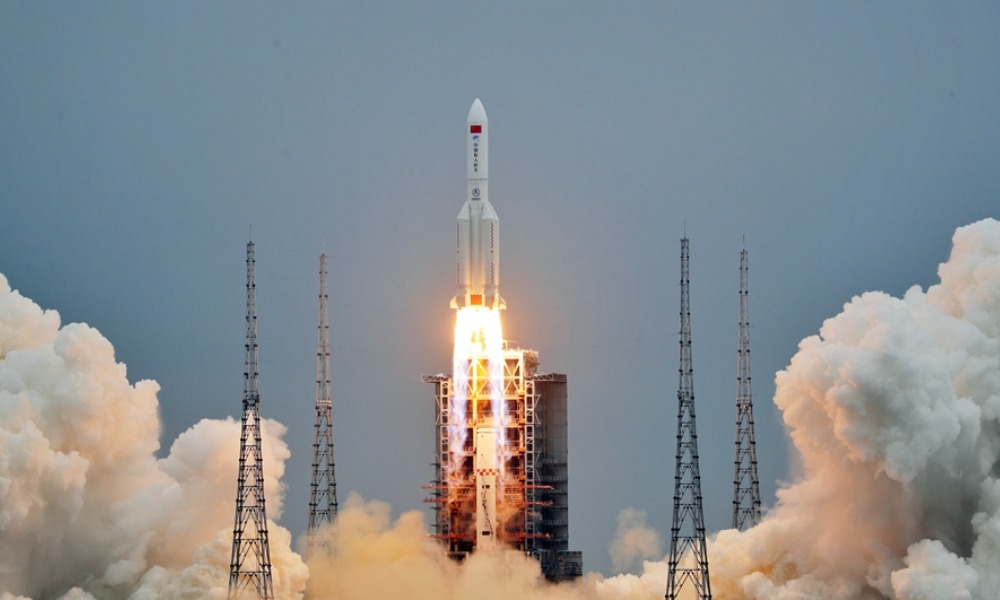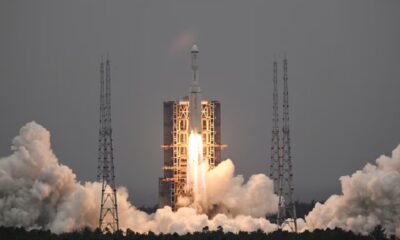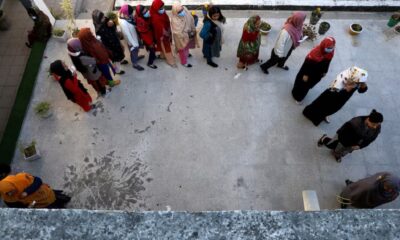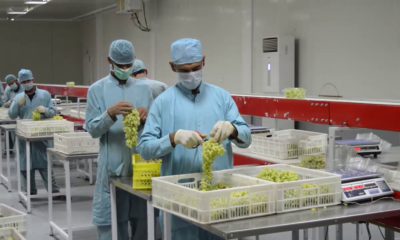Science & Technology
China to launch more than 50 rockets, spacecraft in 2022

China’s aerospace sector is busy going ahead with the preparations for carrying out the nation’s ambitious space exploration scheme of sending over 50 spacecraft into space in 2022, with all work of research and development, production and debugging underway in an orderly manner.
The country plans to launch the Long March-8 Y2 rocket, a two-stage medium-lift rocket between late February and early March this year.
The scheduled mission at the Wenchang Spacecraft Launch Site in south China’s Hainan Province will be the first launch of China’s new configuration of the Long March-8 rocket without boosters.
According to the developer, the rocket will be carrying 22 commercial satellites in the coming mission, the largest number of satellites to be launched in one flight by China.
“Now the Long March-8 Y2 is undergoing sub-system testing. Judged from the progress of our sub-system testing and data interpretation, the current testing results are normal, and the entire rocket is in a controllable condition,” said Wu Yitian, deputy chief designer of the Long March-8 rocket.
China plans to make a record six launches in 2022 to finish building its space station, according to a blue paper released by the China Aerospace Science and Technology Corporation (CASC), the main contractor of China’s space program, on Wednesday.
The launch vehicles scheduled to dock with the space station are standing by, including the Long March 2F Y15, designed to carry three crew members to the station in November this year.
“The Y15 rocket is undergoing testing for final assembly in the workshop, and it will be transported to the Jiuquan Satellite Launch Base for the launch mission after all the jobs are done,” said Jing Muchun, chief designer of the Long March 2F, the carrier rocket system of Tiangong-1, which was China’s first prototype space station.
This year marks the first time for Chinese astronauts to celebrate the Spring Festival in outer space, and the three crew members aboard Shenzhou-13 – Zhai Zhigang, Wang Yaping and Ye Guangfu, have decorated the space station core module with traditional Chinese paper-cuts, Spring Festival Couplets, or Chunlian in Chinese, and red lanterns.
In the Beijing Space Information Transmission Center, space workers checked the system status of the Tianlian relay satellites, a system of relay satellites distributed around the equator in geostationary orbits, to keep the operation of China’s space station under close watch of the staff on the Earth.
“Just because of the broad coverage, long transmission time and high transmission rate of the Tianlian relay satellites, the space station completed the space-to-earth calls, extravehicular activities, and space lectures under its support. In future, the Tianlian relay satellites will provide space-based measurement and control and data relay services for the launch, rendezvous and docking, and in-orbit construction and assembly of space station modules as well as for the various spacecrafts,” said Ma Chao, an engineer with the comprehensive planning department of the Beijing Space Information Transmission Center.
Science & Technology
Apple loses top phonemaker spot to Samsung as iPhone shipments drop, IDC says

Apple’s (AAPL.O), opens new tab smartphone shipments dropped about 10% in the first quarter of 2024, hurt by intensifying competition by Android smartphone makers aiming for the top spot, data from research firm IDC showed on Sunday.
Global smartphone shipments increased 7.8% to 289.4 million units during January-March, with Samsung (005930.KS), opens new tab, at 20.8% market share, clinching the top phonemaker spot from Apple, Reuters reported.
The iPhone-maker’s steep sales decline comes after its strong performance in the December quarter when it overtook Samsung as the world’s No.1 phone maker. It’s back to the second spot, with 17.3% market share, as Chinese brands such as Huawei gain market share.
Xiaomi, one of China’s top smartphone makers, occupied the third position with a market share of 14.1% during the first quarter, read the report.
South Korea’s Samsung, which launched its latest flagship smartphone lineup – Galaxy S24 series – in the beginning of the year, shipped more than 60 million phones during the period.
Global sales of Galaxy S24 smartphones jumped 8%, compared to last year’s Galaxy S23 series during their first three weeks of availability, data provider Counterpoint previously said.
In the first quarter, Apple shipped 50.1 million iPhones, down from 55.4 million units it shipped same period last year, according to IDC.
Apple’s smartphone shipments in China shrank 2.1% in the final quarter of 2023 from a year earlier.
The drop underscores the challenges facing the U.S. firm in its third biggest market, as some Chinese companies and government agencies limit employees’ use of Apple devices, a measure that mirrors U.S. government restrictions on Chinese apps on security grounds.
The Cupertino, California-based company in June will hold its Worldwide Developers Conference (WWDC), where it will highlight updates to the software powering iPhones, iPads, and other Apple devices.
Investors are closely watching for updates on artificial intelligence development at Apple, which has so far spoken little about incorporating the AI technology into its devices. The company earlier this year lost the crown as the world’s most valuable company to Microsoft (MSFT.O), opens new tab, Reuters reported.
Science & Technology
China launch of relay satellite Queqiao-2 for lunar probe mission successful

China National Space Administration (CNSA) said on Friday its launch of a key signal relay satellite was a “complete success” and it would serve as the communication bridge for its future lunar probe missions for years to come, state media reported.
China launched the satellite Queqiao-2, which was named after a mythological bridge made of magpies, and two miniature satellites, Tiandu-1 and Tiandu-2, on March 20.
Queqiao-2 will be used as a communications bridge between the ground operations on earth and upcoming lunar probe missions on the far side of the moon until at least 2030.
The moon’s near side always faces earth. That means data transfers from the far side are impossible because there is no direct line of sight.
Queqiao-2 researcher and developer Xiong Liang described the satellite as “the main switch” of the whole fourth phase of lunar missions, according to state television CCTV.
“Only when the main switch is flipped on, all the communications can kick off,” Xiong said.
Queqiao-2 will orbit the moon and relay signals to and from the Chang’e-6 mission, which expected to be launched in May. The robotic Chang’e-6 probe will seek to retrieve samples from an ancient basin, acquiring lunar material from the moon’s hidden side for the first time.
Queqiao-2 will also be used as a relay platform for the Chang’e-7 lunar mission in 2026 and the Chang’e-8 mission in 2028.
The functions and performance of Queqiao-2 met mission requirements and it will be able to provide relay communication services for China’s lunar exploration projects and future lunar missions for China and other countries, said the CNSA, according to CCTV.
Queqiao-2 entered its targeted elliptical orbit on April 2 after a correction midway, near-moon braking and orbital manoeuvre around the moon, CNSA said.
The satellite has successfully communicated with Chang’e 4, which was the first spacecraft to perform a soft landing on the far side of the moon and is still carrying out its exploration mission. It also communicated with the Chang’e-6 probe while it is still on the ground earlier this month.
The successful launch of Queqiao-2 comes after the failed launch of another lunar spacecraft DRO-A/B satellites, which was intended to enter the moon’s distant retrograde orbit (DRO).
China has not released any information on whether or not the satellites can be retrieved.
(Reuters)
Science & Technology
Russia aborts planned test launch of new heavy-lift space rocket

Russian space officials on Tuesday aborted the test launch of a new heavy-lift rocket from its far-eastern launch pad.
The Angara-A5 rocket was scheduled to lift off from the Vostochny space launch facility at 0900 GMT Tuesday, but the launch was aborted two minutes before, AP reported.
Yuri Borisov, head of Roscosmos state space corporation, said the automatic safety system canceled the launch after registering a flaw in the oxidizer tank pressurization system.
He said the next launch attempt was set for Wednesday.
Tuesday’s launch was to be the fourth for the Angara-A5, a heavy-lift version of the new Angara family of rockets that has been developed to replace the Soviet-designed Proton rockets.
-

 Tahawol5 days ago
Tahawol5 days agoTahawol: Concerns over continuation of acting government discussed
-

 Regional3 days ago
Regional3 days agoIndian foreign ministry advises against travel to Iran, Israel
-

 Latest News4 days ago
Latest News4 days agoAfghanistan withdrawal probe sparks anxiety within Biden administration: US’s McCaul
-

 Latest News3 days ago
Latest News3 days agoTop former US general claims Daesh-Khorasan is ‘on the upswing’
-

 Latest News4 days ago
Latest News4 days agoLightning strikes in Helmand kill one, injure three
-

 Science & Technology4 days ago
Science & Technology4 days agoChina launch of relay satellite Queqiao-2 for lunar probe mission successful
-

 World4 days ago
World4 days agoVoters in many countries sceptical of democracy, poll shows
-

 Business3 days ago
Business3 days agoAfghanistan reaches self-sufficiency in production of 133 items: MoIC
























